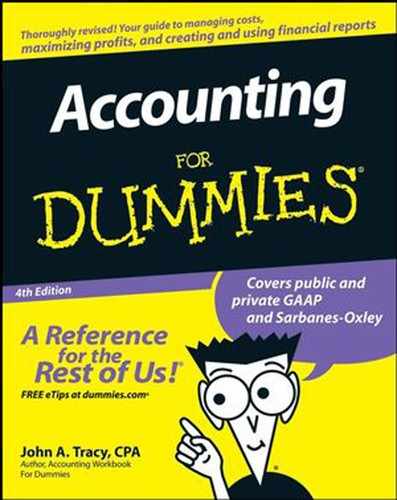4.2. Finding Profit
As I say in the previous section, when reading an income statement your job is asking pertinent questions. Here's an important question: What happened to the business's financial condition as the result of earning $1.69 million net income for the year (refer to Figure 4-1)? The financial condition of a business consists of its assets on the one side and its liabilities and owners' equity on the other side. (The financial condition of a business at a point in time is reported in its balance sheet, which I discuss in detail in Chapter 5.)
To phrase the question a little differently: How did the company's assets, liabilities, and owners' equity change during the year as the result of its revenue and expense transactions that yielded $1.69 million profit? You can't record revenue without increasing a particular asset (or decreasing a particular liability in some cases). And you can't record an expense without decreasing a particular asset or increasing a particular liability. Revenue and expenses are not ephemeral things, like smoke blowing in the wind. These two components of profit cause real changes in assets and liabilities.
When you see the sales revenue in Figure 4-1, you should be thinking that there was $26 million inflow of assets during the year. (In the example, no liabilities are involved in recording sales.) The company's total expenses for the year were $24.31 million ($26 million sales revenue minus $1.69 million net income). Expenses decrease assets or increase liabilities. Therefore, you should be thinking that there was an outflow of assets during the year and probably a run-up of liabilities for a combined total of $24.31 million. In short, sales and expenses cause considerable changes in assets and liabilities. Usually these changes are rumbles, but they can cause a seismic event on occasion.
NOTE
The question can be answered in terms of the accounting equation: a very condensed version of the balance sheet. A useful version of the accounting equation is the following, in which owners' equity is divided between invested capital and retained earnings:
The owners' equity of a business increases for two quite different reasons: The owners invest money in the business, and the business makes a profit. Naturally, a business keeps two types of accounts for owners' equity: one for invested capital and one for retained profit, or retained earnings (as it is generally called). The term retained is used because in most situations some or all of annual profit is not distributed to owners but is retained in the business. Unfortunately, the retained earnings account sounds like an asset in the minds of many people. It is not! It is a source-of-assets account, not an asset account. It's on the right-hand side of the accounting equation; assets are on the left side. See the "So why is it called retained earnings?" sidebar for more information.
NOTE
So why is it called retained earnings?The ending balance reported in the retained earnings account is the amount after recording increases and decreases in the account during the period, starting with the opening balance at the start of the period, of course. The retained earnings account increases when the business makes a profit and decreases when the business distributes some of the profit to its owners. That is, the total amount of profit paid out to the owners is recorded as a decrease in the retained earnings account. (Exactly how the profit is divided among the owners depends on the ownership structure of the business; see Chapter 8.) Bonus question: Why doesn't a business pay out all its annual profit to owners? One reason is that the business may not have converted all its profit into cash by the end of the year and may not have enough cash to distribute all the profit to the owners. Or the business may have had the cash but needed it for other purposes, such as growing the company by buying new buildings and equipment or spending the money on research and development of new products. Reinvesting the profit in the business in this way is often referred to as plowing back earnings. A business should always make good use of its cash flow instead of letting the cash pile up in the cash account. See Chapter 6 for more on cash flow from profit. |
The business in the Figure 4-1 example earned $1.69 million profit for the year. Therefore, its retained earnings account increased this amount, because the bottom-line amount of net income for the period is recorded in this account. We know this for sure. But what we can't tell from the income statement is how the assets and liabilities of the business were affected by its sale and expense activities during the period. One possible scenario is the following (in thousands of dollars):

This scenario works because the sum of the right-hand-side changes ($300,000 increase in liabilities plus $1.69 million increase in retained earnings) equals the $1.99 million increase in assets.
|
To summarize, the company's $1.69 million net income resulted in some combination of changes in its assets and liabilities, such that its owners' equity (specifically, its retained earnings) increased $1.69 million. One such scenario is given just above. In fact, this is what happened in the business example, which I summarize later in the chapter (see the section "Summing Up the Financial Effects of Profit").

